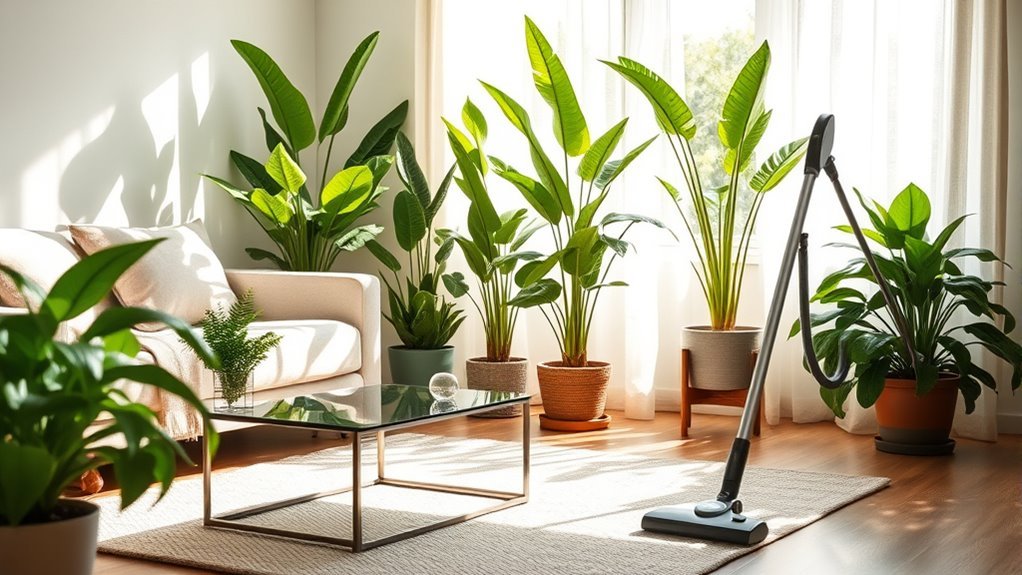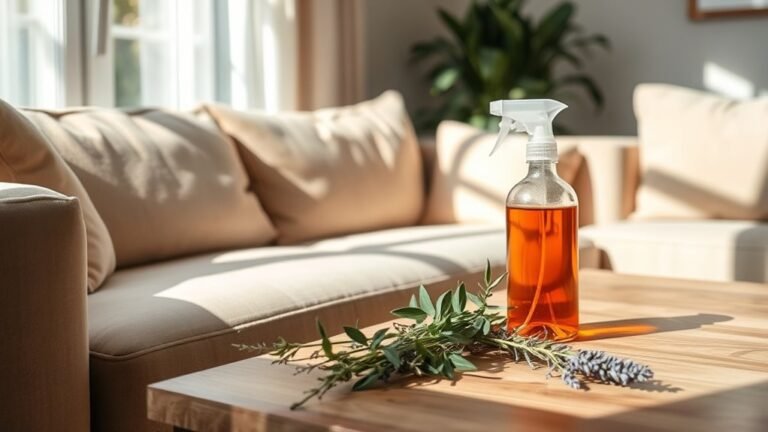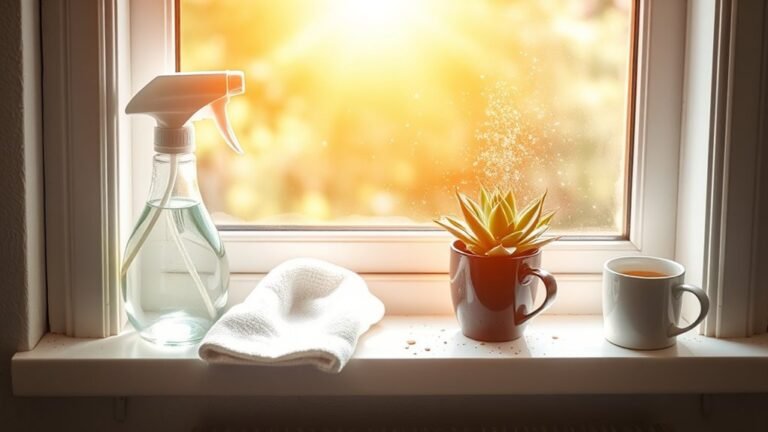Preventing Dirt Buildup on Living Room
To prevent dirt buildup in your living room, start by setting a no-shoes policy and placing doormats at entry points to catch debris early. Regularly vacuum and sweep floors, and dust surfaces frequently to keep allergens and dust at bay. Maintain indoor plants for better air quality and control humidity levels. Keep clutter down with regular organization and deep cleaning sessions. With a few simple habits, your living room will stay cleaner and more inviting every day—there’s plenty more you can do to enhance it.
Establish a No-Shoes Policy

Although it might seem like a small step, establishing a no-shoes policy can greatly reduce dirt buildup in your living room. By asking guests and family members to remove their shoes, you’re keeping outdoor grime from invading your personal space. You don’t have to sacrifice comfort or style either; shoe alternatives like slippers or cozy socks provide freedom while protecting your floors. Consider pairing this policy with durable floor coverings that are easy to clean, such as washable rugs or mats. These coverings act as an extra barrier against dirt, making maintenance simpler and preserving your living room’s freshness. Embracing this habit gives you control over your environment without feeling restricted—allowing you to enjoy a cleaner, more inviting space without hassle or compromise.
Use Doormats at Entry Points
Since entry points are the main channels for dirt to enter your living room, using doormats is an effective way to catch debris before it spreads. You’re free to choose doormat materials that suit your lifestyle—coir for heavy-duty scraping, rubber for weather resistance, or microfiber for trapping dust. Picking the right doormat doesn’t just keep dirt out; it also enhances your entryway aesthetics. A well-chosen mat can complement your decor and create a welcoming vibe, making your space feel open and inviting. By placing sturdy, attractive doormats right at your doors, you take control of dirt before it sneaks inside, giving you the freedom to enjoy a cleaner, more comfortable living room without constant worry about messes tracking in.
Regularly Vacuum and Sweep Floors

Keep your living room floors spotless by regularly vacuuming and sweeping. It’s the key to maintaining a fresh, dirt-free space without feeling tied down by cleaning chores. Different floor types need specific vacuuming techniques to be effective and gentle. Here’s how you can stay ahead of dirt buildup:
- For carpets and rugs, use a vacuum with adjustable height settings to reach deep dirt without damaging fibers.
- Hardwood and laminate floors benefit from a vacuum with a brush roll you can disable to avoid scratches.
- Sweep tile or vinyl floors daily to prevent grit from wearing down the surface.
Dust Surfaces Frequently
Dusting surfaces frequently helps you maintain a clean and healthy living room by removing allergens and preventing buildup. You’ll find that using the right dusting techniques tailored to your surface materials makes the job easier and more effective. For example, microfiber cloths work wonders on wood and glass, trapping dust without scratching. For delicate or textured surfaces, try a soft-bristled brush to reach crevices without damage. Don’t forget to dust overlooked spots like shelves, electronics, and baseboards regularly to stop dust from settling. By making dusting a routine, you’re freeing yourself from the constant cycle of grime and creating a space where you can relax without worry. Remember, consistent care keeps your living room inviting and fresh.
Maintain Indoor Plants for Air Quality

To keep your living room air fresh, choose low-maintenance indoor plants that fit your lifestyle. Make sure you regularly dust their leaves to prevent dirt buildup and help them breathe better. Also, use proper watering techniques to avoid overwatering and keep your plants healthy.
Choose Low-Maintenance Plants
Although indoor plants can brighten your living room and improve air quality, not all of them require constant care. If you want freedom from high-maintenance greenery, choose plants that thrive with minimal attention. Here are three low-maintenance plants perfect for your space:
- Snake Plant – great low light options and nearly indestructible.
- Spider Plant – pet friendly choices that tolerate varied environments.
- ZZ Plant – thrives on neglect and adds lush green vibes effortlessly.
Picking these plants means you won’t have to stress over watering schedules or lighting needs. They help keep your living room fresh without adding chores. Plus, pet friendly choices let you relax knowing your furry friends are safe. So, go ahead and enjoy cleaner air with plants that fit your easygoing lifestyle.
Regularly Dust Plant Leaves
Keeping your low-maintenance plants looking their best means paying attention to more than just watering. Regular leaf cleaning is a simple but essential part of plant care that often gets overlooked. Dust buildup on leaves blocks sunlight, reducing your plant’s ability to photosynthesize and thrive. By gently wiping leaves with a damp cloth or using a soft brush, you help your plants breathe easier and look vibrant. Doing this regularly keeps your living room fresh and free from hidden dirt. Plus, it’s a quick task that fits perfectly into a relaxed routine, giving you more freedom to enjoy your space without worrying about grime. Remember, consistent leaf cleaning not only boosts plant health but also improves your indoor air quality effortlessly.
Proper Watering Techniques
When you water your indoor plants properly, you not only support their growth but also enhance the air quality in your living room. To keep dirt buildup at bay and maintain your plants’ health, focus on these key steps:
- Check moisture levels regularly—stick your finger about an inch into the soil. If it feels dry, it’s time to water.
- Adjust watering frequency based on the season and plant type; avoid overwatering, which can cause mold and attract dirt.
- Water thoroughly but gently until excess drains from the pot, ensuring roots get enough hydration without pooling water.
Choose Easy-to-Clean Furniture
Since your living room furniture often takes the brunt of daily use, choosing pieces that are easy to clean can save you time and effort. Opt for durable fabric types like leather or tightly woven microfiber that resist stains and wipe down easily. Also, consider furniture placement; avoid cramped spots where dirt and dust accumulate, making cleaning tougher.
| Fabric Type | Cleaning Ease |
|---|---|
| Leather | Wipe with damp cloth |
| Microfiber | Vacuum or spot clean |
| Cotton Blend | Requires frequent washing |
| Velvet | Needs professional cleaning |
| Synthetic Fibers | Generally easy maintenance |
Implement a Weekly Deep Cleaning Routine
Although daily tidying helps, you’ll need a weekly deep cleaning routine to truly prevent dirt buildup in your living room. This routine guarantees your space stays fresh, letting you enjoy freedom from constant mess. Start by gathering all necessary cleaning supplies—vacuum, microfiber cloths, and all-purpose cleaner—to streamline your effort. Then, prioritize your time management by setting a specific day and sticking to it. Here’s a simple plan to follow:
- Vacuum thoroughly, hitting corners and under furniture.
- Wipe down surfaces, including shelves, tables, and electronics.
- Clean windows and mirrors for a brighter, clearer room.
Manage Pet Hair and Dander
Keeping your living room free from dirt means paying special attention to pet hair and dander, which can quickly accumulate and affect cleanliness. You can stay ahead by regularly using grooming tools to reduce shedding and choosing pet friendly fabrics that resist hair buildup. These steps give you more freedom to enjoy your space without constant cleaning stress.
| Action | Benefit |
|---|---|
| Regular brushing | Reduces loose hair |
| Vacuum with pet filter | Captures dander and fur |
| Use pet friendly fabrics | Easier to clean and maintain |
| Wash pet bedding weekly | Limits dander in the room |
Control Humidity Levels
When you control humidity levels in your living room, you prevent moisture buildup that can attract dust and mold. Maintaining proper humidity control helps you enjoy a fresh, clean space without the hassle of constant dirt accumulation. To achieve the right moisture balance, follow these steps:
- Use a hygrometer to monitor indoor humidity, aiming for 30-50% for ideal comfort and cleanliness.
- Employ a dehumidifier or humidifier as needed to adjust moisture levels, keeping the air neither too dry nor too damp.
- Make certain proper ventilation by opening windows or using exhaust fans to circulate air and reduce stagnant moisture.
Organize and Declutter Regularly
Since clutter can trap dust and make cleaning harder, organizing your living room regularly is essential. Embracing minimalist decor helps you maintain freedom from chaos and simplifies upkeep. Smart storage solutions reduce surface mess and keep dirt at bay, giving you more time to enjoy your space.
| Declutter Tips | Storage Solutions | Minimalist Decor |
|---|---|---|
| Sort items weekly | Use multi-purpose bins | Choose neutral colors |
| Donate unused goods | Install hidden shelves | Limit decorative items |
| Keep surfaces clear | Opt for furniture with built-in storage | Select functional pieces |
Frequently Asked Questions
How Do Air Purifiers Help Reduce Dirt in the Living Room?
Air purifiers help improve your living room’s air quality by capturing dust particles and other airborne contaminants. When you run one, it filters out dirt, pollen, and allergens floating around, so you breathe cleaner air. This means less dust settling on your furniture, giving you more freedom to enjoy a fresh, comfortable space without constant cleaning. It’s like having a barrier against dirt, keeping your room cleaner effortlessly.
What Types of Flooring Attract the Least Dirt?
If you want flooring that doesn’t hold onto dirt, vinyl flooring and tile flooring are great choices. They’re smooth surfaces, so dirt doesn’t stick around as much, making cleanup a breeze. You won’t feel trapped by constant sweeping or scrubbing, giving you more freedom to enjoy your space. Plus, both options are durable and stylish, so you don’t have to sacrifice looks while keeping things cleaner effortlessly.
Can Certain Lighting Reduce the Appearance of Dirt?
Back in the days of quills and parchment, lighting wasn’t a concern, but today, you can totally use ambient lighting to reduce dirt’s visibility. When you choose lighting with a warmer color temperature, it softens shadows and makes dirt less noticeable. Cooler, harsher lights highlight imperfections, so stick to warm, cozy hues. This way, you maintain your freedom to enjoy a clean-looking space without obsessing over every speck.
How Often Should HVAC Filters Be Replaced to Prevent Dust?
You should replace your HVAC filters every 1 to 3 months to keep dust circulation in check. Regular filter maintenance guarantees cleaner air and helps your system run smoothly, giving you the freedom to breathe easy without constant worry. If you have pets or allergies, changing filters more often is a smart move. Staying on top of this simple task lets you enjoy a fresher, healthier space effortlessly.
Are Natural Cleaning Products Effective Against Dirt Buildup?
Did you know that 90% of people say they prefer eco friendly solutions for their home cleaning? If you’re wondering about natural cleaning products’ effectiveness, they can be surprisingly powerful against dirt buildup. Many harness ingredients like vinegar and baking soda, offering solid cleaning effectiveness without harsh chemicals. Plus, they give you the freedom to keep your space fresh while protecting your health and the environment. It’s a win-win!






